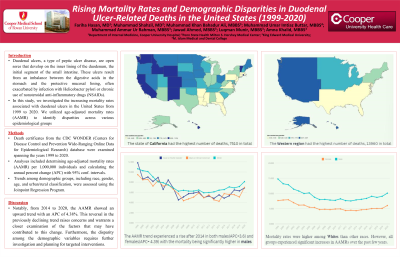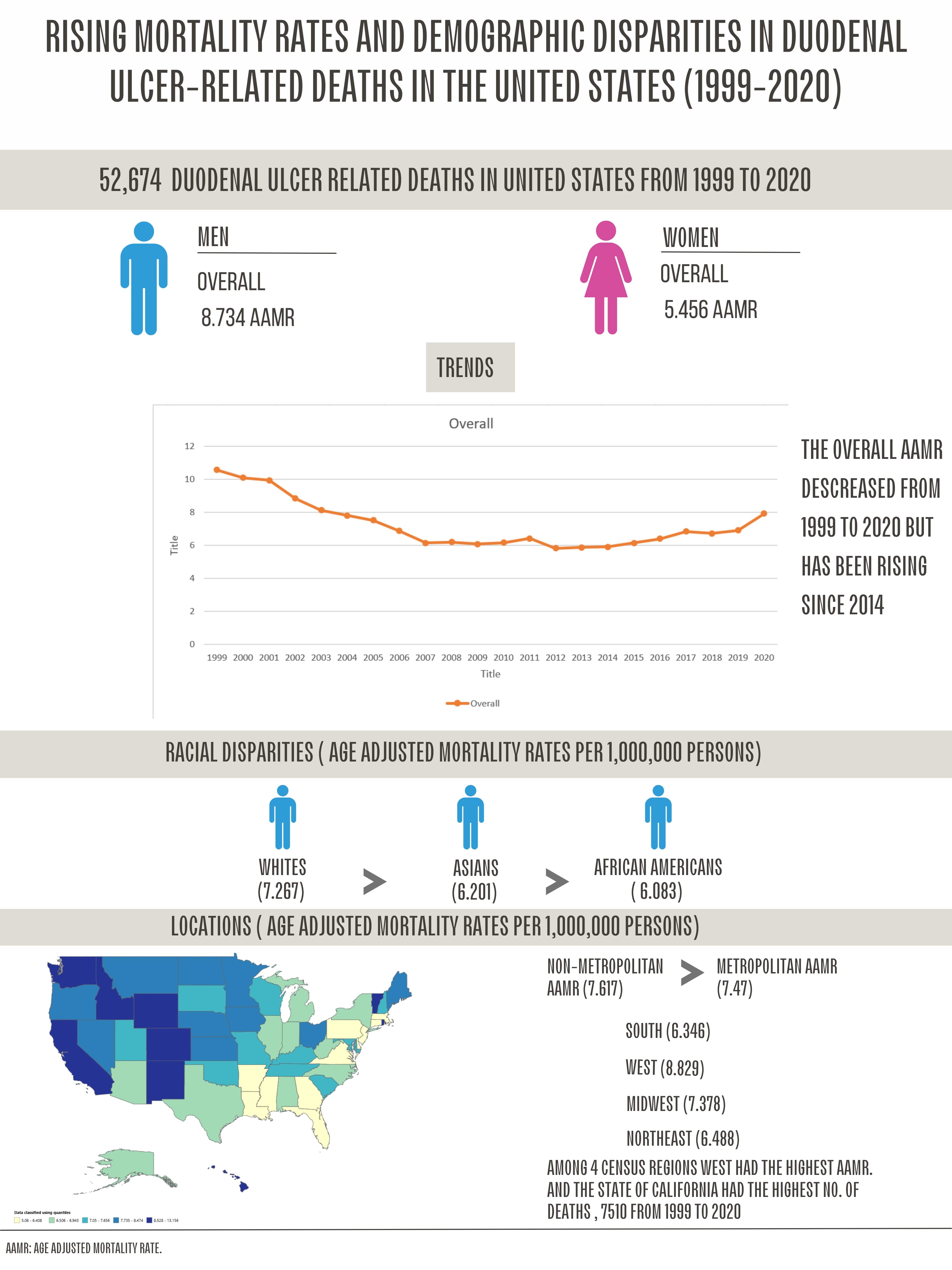Monday Poster Session
Category: Small Intestine
P3184 - Rising Mortality Rates and Demographic Disparities in Duodenal Ulcer-Related Deaths in the United States (1999-2020)
Monday, October 28, 2024
10:30 AM - 4:00 PM ET
Location: Exhibit Hall E

Has Audio

Fariha Hasan, MD
Cooper University Hospital
Philadelphia, PA
Presenting Author(s)
Fariha Hasan, MD1, Muhammad Shahzil, MD2, Muhammad Khan Bahadur Ali, MBBS3, Muhammad Umar Imtiaz Buttar, MBBS4, Muhammad Ammar Ur Rahman, MBBS3, Jawad Ahmed, MBBS3, Luqman Munir, MBBS3, Amna Khalid, MBBS3
1Cooper University Hospital, Philadelphia, PA; 2Penn State Health Milton S. Hershey Medical Center, Hershey, PA; 3King Edward Medical University, Lahore, Punjab, Pakistan; 4M. Islam Medical and Dental College, Sialkot, Punjab, Pakistan
Introduction: Duodenal ulcers, a type of peptic ulcer disease, are open sores that develop on the inner lining of the duodenum. These ulcers result from an imbalance between the digestive acids in the stomach and the protective mucosal lining, often exacerbated by infection with Helicobacter pylori or chronic use of nonsteroidal anti-inflammatory drugs (NSAIDs). Symptoms typically include burning abdominal pain, bloating, and nausea, which can significantly impact a patient's quality of life. Our study examined the rising mortality rates linked to duodenal ulcers in the United States between 1999 and 2020 using age-adjusted mortality rates (AAMR) to pinpoint disparities among different epidemiological groups.
Methods: We analyzed death certificates from the CDC WONDER (Centers for Disease Control and Prevention Wide-Ranging Online Data for Epidemiological Research) database from 1999 to 2020. Our analyses involved calculating age AAMR per 1,000,000 individuals and determining the annual percent change (APC) with 95% confidence intervals. We assessed trends among various demographic groups, such as race, gender, age, and urban/rural classification, using the Joinpoint Regression Program.
Results: Between 1999 and 2020, there were 52,674 reported deaths due to duodenal ulcers. The overall age-adjusted mortality rate (AAMR) displayed an inconsistent trend, with an average annual percent change (AAPC) of -1.69%. From 1999 to 2007, the AAMR experienced a sharp decline with an APC of -6.47%, followed by a gradual downward trend from 2007 to 2014 with an APC of -1.14%. However, from 2014 to 2020, the AAMR showed an upward trend with an APC of 4.38%. The AAMR decreased from 10.568 in 1999 to 7.938 in 2020. The highest mortality rates were observed in individuals aged 85 and above, Whites, and males. Geographical hotspots included the western and suburban regions, with most deaths occurring in inpatient medical facilities. Tests for parallelism revealed significant differences across western and southern regions (p=0.0029) and between urban (large central metro) and suburban (micropolitan) areas (p=0.0111).
Discussion: Notably, from 2014 to 2020, the AAMR showed an upward trend with an APC of 4.38%. This reversal in the previously declining trend raises concerns and warrants a closer examination of the factors that may have contributed to this change. Furthermore, the disparity among the demographic variables requires further investigation and planning for targeted interventions.

Disclosures:
Fariha Hasan, MD1, Muhammad Shahzil, MD2, Muhammad Khan Bahadur Ali, MBBS3, Muhammad Umar Imtiaz Buttar, MBBS4, Muhammad Ammar Ur Rahman, MBBS3, Jawad Ahmed, MBBS3, Luqman Munir, MBBS3, Amna Khalid, MBBS3. P3184 - Rising Mortality Rates and Demographic Disparities in Duodenal Ulcer-Related Deaths in the United States (1999-2020), ACG 2024 Annual Scientific Meeting Abstracts. Philadelphia, PA: American College of Gastroenterology.
1Cooper University Hospital, Philadelphia, PA; 2Penn State Health Milton S. Hershey Medical Center, Hershey, PA; 3King Edward Medical University, Lahore, Punjab, Pakistan; 4M. Islam Medical and Dental College, Sialkot, Punjab, Pakistan
Introduction: Duodenal ulcers, a type of peptic ulcer disease, are open sores that develop on the inner lining of the duodenum. These ulcers result from an imbalance between the digestive acids in the stomach and the protective mucosal lining, often exacerbated by infection with Helicobacter pylori or chronic use of nonsteroidal anti-inflammatory drugs (NSAIDs). Symptoms typically include burning abdominal pain, bloating, and nausea, which can significantly impact a patient's quality of life. Our study examined the rising mortality rates linked to duodenal ulcers in the United States between 1999 and 2020 using age-adjusted mortality rates (AAMR) to pinpoint disparities among different epidemiological groups.
Methods: We analyzed death certificates from the CDC WONDER (Centers for Disease Control and Prevention Wide-Ranging Online Data for Epidemiological Research) database from 1999 to 2020. Our analyses involved calculating age AAMR per 1,000,000 individuals and determining the annual percent change (APC) with 95% confidence intervals. We assessed trends among various demographic groups, such as race, gender, age, and urban/rural classification, using the Joinpoint Regression Program.
Results: Between 1999 and 2020, there were 52,674 reported deaths due to duodenal ulcers. The overall age-adjusted mortality rate (AAMR) displayed an inconsistent trend, with an average annual percent change (AAPC) of -1.69%. From 1999 to 2007, the AAMR experienced a sharp decline with an APC of -6.47%, followed by a gradual downward trend from 2007 to 2014 with an APC of -1.14%. However, from 2014 to 2020, the AAMR showed an upward trend with an APC of 4.38%. The AAMR decreased from 10.568 in 1999 to 7.938 in 2020. The highest mortality rates were observed in individuals aged 85 and above, Whites, and males. Geographical hotspots included the western and suburban regions, with most deaths occurring in inpatient medical facilities. Tests for parallelism revealed significant differences across western and southern regions (p=0.0029) and between urban (large central metro) and suburban (micropolitan) areas (p=0.0111).
Discussion: Notably, from 2014 to 2020, the AAMR showed an upward trend with an APC of 4.38%. This reversal in the previously declining trend raises concerns and warrants a closer examination of the factors that may have contributed to this change. Furthermore, the disparity among the demographic variables requires further investigation and planning for targeted interventions.

Figure: Rising Mortality Rates and Demographic Disparities in Duodenal Ulcer-Related Deaths in the United States
Disclosures:
Fariha Hasan indicated no relevant financial relationships.
Muhammad Shahzil indicated no relevant financial relationships.
Muhammad Khan Bahadur Ali indicated no relevant financial relationships.
Muhammad Umar Imtiaz Buttar indicated no relevant financial relationships.
Muhammad Ammar Ur Rahman indicated no relevant financial relationships.
Jawad Ahmed indicated no relevant financial relationships.
Luqman Munir indicated no relevant financial relationships.
Amna Khalid indicated no relevant financial relationships.
Fariha Hasan, MD1, Muhammad Shahzil, MD2, Muhammad Khan Bahadur Ali, MBBS3, Muhammad Umar Imtiaz Buttar, MBBS4, Muhammad Ammar Ur Rahman, MBBS3, Jawad Ahmed, MBBS3, Luqman Munir, MBBS3, Amna Khalid, MBBS3. P3184 - Rising Mortality Rates and Demographic Disparities in Duodenal Ulcer-Related Deaths in the United States (1999-2020), ACG 2024 Annual Scientific Meeting Abstracts. Philadelphia, PA: American College of Gastroenterology.
